非谓语动词三
非谓语动词三大形式
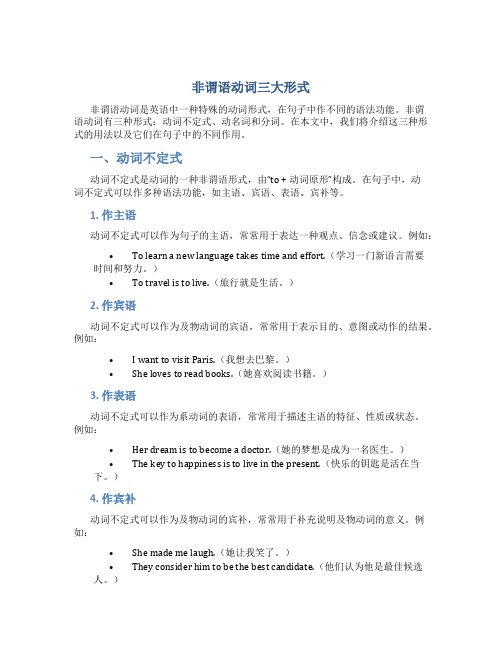
非谓语动词三大形式非谓语动词是英语中一种特殊的动词形式,在句子中作不同的语法功能。
非谓语动词有三种形式:动词不定式、动名词和分词。
在本文中,我们将介绍这三种形式的用法以及它们在句子中的不同作用。
一、动词不定式动词不定式是动词的一种非谓语形式,由“to + 动词原形”构成。
在句子中,动词不定式可以作多种语法功能,如主语、宾语、表语、宾补等。
1. 作主语动词不定式可以作为句子的主语,常常用于表达一种观点、信念或建议。
例如:•To learn a new language takes time and effort.(学习一门新语言需要时间和努力。
)•To travel is to live.(旅行就是生活。
)2. 作宾语动词不定式可以作为及物动词的宾语,常常用于表示目的、意图或动作的结果。
例如:•I want to visit Paris.(我想去巴黎。
)•She loves to read books.(她喜欢阅读书籍。
)3. 作表语动词不定式可以作为系动词的表语,常常用于描述主语的特征、性质或状态。
例如:•Her dream is to become a doctor.(她的梦想是成为一名医生。
)•The key to happiness is to live in the present.(快乐的钥匙是活在当下。
)4. 作宾补动词不定式可以作为及物动词的宾补,常常用于补充说明及物动词的意义。
例如:•She made me laugh.(她让我笑了。
)•They consider him to be the best candidate.(他们认为他是最佳候选人。
)二、动名词动名词是动词的一种非谓语形式,以-ing结尾。
在句子中,动名词可以作多种语法功能,如主语、宾语、表语、宾补等。
1. 作主语动名词可以作为句子的主语,常常用于表示一种习惯、经验或普遍情况。
例如:•Running helps to keep me fit.(跑步有助于保持健康。
非谓语的三种形式

非谓语的三种形式非谓语是指在句子中不充当谓语的动词形式。
一般包括三种形式:不定式、动名词和分词。
非谓语在英语中的使用频率非常高,掌握好非谓语的用法对于提高英语水平非常重要。
一、不定式不定式是指以to+动词原形构成的动词形式。
不定式可以用作名词、形容词和副词的修饰语,还可以用来表示目的、结果、原因、条件、方式等。
1. 作名词不定式作为名词可以用来表示动作的概念,如:To learn English well is very important.学好英语非常重要。
It’s important for us to learn English well.我们学好英语很重要。
2. 作形容词不定式作为形容词可以用来修饰名词,如:I have a lot of work to do.我有很多工作要做。
It’s a difficult task to complete.这是一个很难完成的任务。
3. 作副词不定式作为副词可以修饰动词、形容词和副词,如:He works hard to support his family.他努力工作来养家。
She was too tired to continue.她太累了,不能继续了。
二、动名词动名词是指以-ing结尾的动词形式,它可以用作名词、形容词和副词的修饰语,还可以用来表示持续性动作或者正在进行的动作。
1. 作名词动名词作为名词可以用来表示一种行为或者状态,如:Swimming is my favorite sport.游泳是我最喜欢的运动。
Reading is a good way to improve your English.阅读是提高英语的好方法。
2. 作形容词动名词作为形容词可以用来修饰名词,如:I have a boring job.我有一份无聊的工作。
The exciting movie made me happy.这部令人激动的电影让我很开心。
3. 作副词动名词作为副词可以修饰动词、形容词和副词,如:She smiled, looking very happy.她微笑着,看起来很开心。
动词的非谓语形式有三种
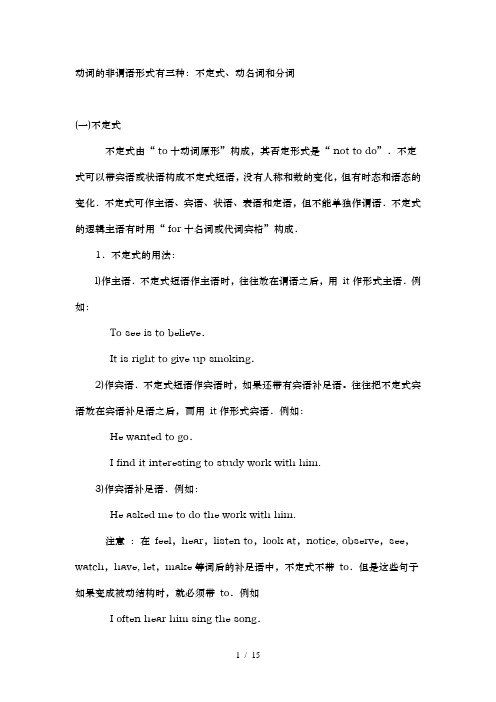
动词的非谓语形式有三种:不定式、动名词和分词(一)不定式不定式由“ to十动词原形”构成,其否定形式是“ not to do”.不定式可以带宾语或状语构成不定式短语,没有人称和数的变化,但有时态和语态的变化.不定式可作主语、宾语、状语、表语和定语,但不能单独作谓语.不定式的逻辑主语有时用“ for十名词或代词宾格”构成.1.不定式的用法:l)作主语.不定式短语作主语时,往往放在谓语之后,用it作形式主语.例如:To see is to believe.It is right to give up smoking.2)作宾语.不定式短语作宾语时,如果还带有宾语补足语。
往往把不定式宾语放在宾语补足语之后,而用it作形式宾语.例如:He wanted to go.I find it interesting to study work with him.3)作宾语补足语.例如:He asked me to do the work with him.注意:在feel,hear,listen to,look at,notice, observe,see,watch,have, let,make等词后的补足语中,不定式不带to.但是这些句子如果变成被动结构时,就必须带to.例如I often hear him sing the song.He is often heard to sing the song.注意:不定式动词在介词but,except,besides后面时,如果这些介词之前有行为动词do的各种形式,那么,这些介词后的不定式不带to,否则要带to.如:She could do nothing but cry.What do you like to do besides swim?I have no choice but to go.4)作定语.例如:I have some books for you to read.注①作定语的不定式如果是不与物动词,或者不定式所修饰的名词或代词是不定式动作的地点、工具等,不定式后面须有相应的介词.例如:He is looking for a room to live in.There is nothing to worry about.Please give me a knife to cut with.但是,不定式所修饰的名词如果是time,place或way,不定式后面的介词习惯上要省去.例如:He had no money and no place to live.注②当作定语的不定式所修饰的名词或代词是不定式动作的承受者时,不定式既可以用主动语态,也可用被动语态,但其含义有所不同.试比较:A) Have you anything to send? 你有什么东西要寄吗?(不定式to send的动作执行者是you)B) Have you anything to be sent? 你有什么要(我或别人)寄的东西吗?(不定式to be sent的动作执行者是已被省略的me 或someone else)5)作状语,表示目的、原因、结果或条件.例如:I came here to see you.(目的)We were very excited to hear the news.(原因)He hurried to the school to find nobody there.(结果)To look at him, you would like him.(条件)目的状语还可以用in order to或so as to来表示.如:In order to pass the exam, he worked very hard.We ran all the way so as not to be late.不定式也可在作表语用的形容词后面作状语.例如:I am very glad to hear it.The question is difficult to answer.“ too十形容词或副词十不定式”作状语.例如:He is too old to do that.另外句子中有enough这个词时,常用不定式作状语.例如:The room is big enough to hold us.6)作表语.例如:My job is to help the patient.7)作独立成分.例如:To tell the truth,I don’t agree with you.8)不定式与疑问词who,which,when,where,how,what等连用,在句中起名词作用,可充当主语、表语、宾语等.例如:He didn’t know what to say.(宾语)How to solve the problem is very important.(主语)My question is when to start. (表语)注意:在与why连用时,只用于why或why not开头的简短疑问句中,后面紧跟的动词不定式不带to. 例如:Why not have a rest?9)不定式在句中用主动式还是被动式。
非谓语动词做后置定语的三种形式
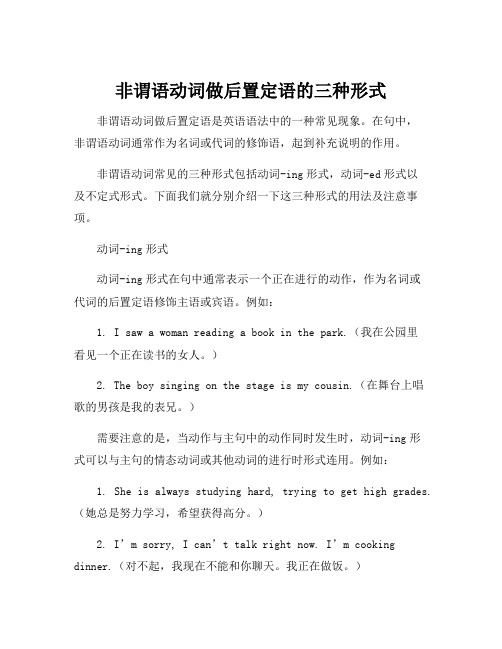
非谓语动词做后置定语的三种形式非谓语动词做后置定语是英语语法中的一种常见现象。
在句中,非谓语动词通常作为名词或代词的修饰语,起到补充说明的作用。
非谓语动词常见的三种形式包括动词-ing形式,动词-ed形式以及不定式形式。
下面我们就分别介绍一下这三种形式的用法及注意事项。
动词-ing形式动词-ing形式在句中通常表示一个正在进行的动作,作为名词或代词的后置定语修饰主语或宾语。
例如:1. I saw a woman reading a book in the park.(我在公园里看见一个正在读书的女人。
)2. The boy singing on the stage is my cousin.(在舞台上唱歌的男孩是我的表兄。
)需要注意的是,当动作与主句中的动作同时发生时,动词-ing形式可以与主句的情态动词或其他动词的进行时形式连用。
例如:1. She is always studying hard, trying to get high grades.(她总是努力学习,希望获得高分。
)2. I’m sorry, I can’t talk right now. I’m cooking dinner.(对不起,我现在不能和你聊天。
我正在做饭。
)动词-ed形式动词-ed形式通常表示完成的动作或对主语或宾语造成的影响或结果。
例如:1. The movie bored me. (这部电影让我感到无聊。
)2. The book written by the famous author was really good.(那个著名作家写的书非常好。
)需要注意的是,动词-ed形式还可以用来修饰某些情态动词或助动词,形成被动语态,例如:1. The letter has been written by my secretary.(这封信已经被我的秘书写好了。
)2. The house was built by my grandfather many years ago.(这个房子是我祖父很多年前建造的。
动词的非谓语形式有三种
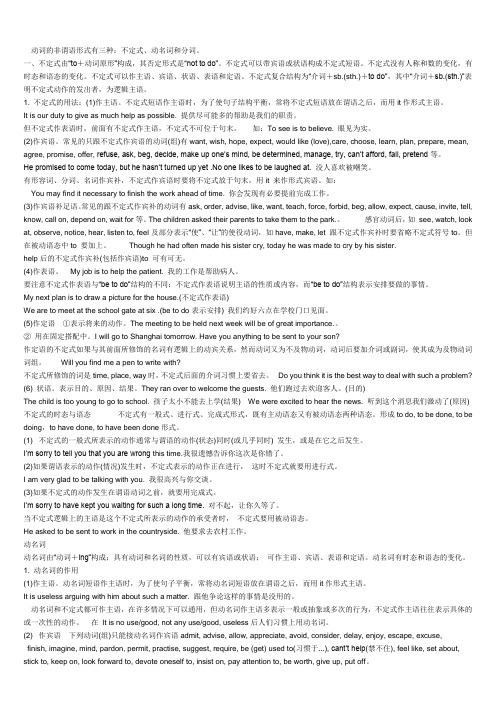
动词的非谓语形式有三种:不定式、动名词和分词。
一、不定式由“to+动词原形”构成,其否定形式是“not to do”。
不定式可以带宾语或状语构成不定式短语。
不定式没有人称和数的变化,有时态和语态的变化。
不定式可以作主语、宾语、状语、表语和定语。
不定式复合结构为“介词+sb.(sth.)+to do”,其中“介词+sb.(sth.)”表明不定式动作的发出者,为逻辑主语。
1. 不定式的用法:(1)作主语。
不定式短语作主语时,为了使句子结构平衡,常将不定式短语放在谓语之后,而用it作形式主语。
It is our duty to give as much help as possible. 提供尽可能多的帮助是我们的职责。
但不定式作表语时,前面有不定式作主语,不定式不可位于句末。
如:To see is to believe. 眼见为实。
(2)作宾语。
常见的只跟不定式作宾语的动词(组)有want, wish, hope, expect, would like (love),care, choose, learn, plan, prepare, mean, agree, promise, offer, refuse, ask, beg, decide, make up one’s mind, be determined, manage, try, can’t afford, fail, pretend等。
He promised to come today, but he hasn’t turned up yet .No one likes to be laughed at. 没人喜欢被嘲笑。
有形容词、分词、名词作宾补,不定式作宾语时要将不定式放于句末,用it 来作形式宾语。
如:You may find it necessary to finish the work ahead of time. 你会发现有必要提前完成工作。
动词的非谓语形式有三种

动词的非谓语形式有三种动词的非谓语形式有三种:不定式、动名词和分词(一)不定式不定式由“ to十动词原形”构成,其否定形式是“ not to do”.不定式可以带宾语或状语构成不定式短语,没有人称和数的变化,但有时态和语态的变化.不定式可作主语、宾语、状语、表语和定语,但不能单独作谓语.不定式的逻辑主语有时用“ for十名词或代词宾格”构成.1.不定式的用法:l)作主语.不定式短语作主语时,往往放在谓语之后,用it作形式主语.例如:To see is to believe.It is right to give up smoking.2)作宾语.不定式短语作宾语时,如果还带有宾语补足语。
往往把不定式宾语放在宾语补足语之后,而用it作形式宾语.例如:He wanted to go.I find it interesting to study work with him.3)作宾语补足语.例如:He asked me to do the work with him.注意:在feel,hear,listen to,look at,notice, observe,see,watch,have, let,make等词后的补足语中,不定式不带to.但是这些句子如果变成被动结构时,就必须带to.例如I often hear him sing the song.He is often heard to sing the song.注意:不定式动词在介词but,except,besides后面时,如果这些介词之前有行为动词do的各种形式,那么,这些介词后的不定式不带to,否则要带to.如:She could do nothing but cry.What do you like to do besides swim?I have no choice but to go.4)作定语.例如:I have some books for you to read.注①作定语的不定式如果是不及物动词,或者不定式所修饰的名词或代词是不定式动作的地点、工具等,不定式后面须有相应的介词.例如:He is looking for a room to live in.There is nothing to worry about.Please give me a knife to cut with.但是,不定式所修饰的名词如果是time,place或way,不定式后面的介词习惯上要省去.例如:He had no money and no place to live.注②当作定语的不定式所修饰的名词或代词是不定式动作的承受者时,不定式既可以用主动语态,也可用被动语态,但其含义有所不同.试比较:A) Have you anything to send? 你有什么东西要寄吗?(不定式to send的动作执行者是you)B) Have you anything to be sent? 你有什么要(我或别人)寄的东西吗?(不定式to be sent的动作执行者是已被省略的me 或someone else)5)作状语,表示目的、原因、结果或条件.例如:I came here to see you.(目的)We were very excited to hear the news.(原因)He hurried to the school to find nobody there.(结果)To look at him, you would like him.(条件)目的状语还可以用in order to或so as to来表示.如:In order to pass the exam, he worked very hard.We ran all the way so as not to be late.不定式也可在作表语用的形容词后面作状语.例如:I am very glad to hear it.The question is difficult to answer.“ too十形容词或副词十不定式”作状语.例如:He is too old to do that.另外句子中有enough这个词时,常用不定式作状语.例如:The room is big enough to hold us.6)作表语.例如:My job is to help the patient.7)作独立成分.例如:To tell the truth,I don’t agree with you.8)不定式与疑问词who,which,when,where,how,what等连用,在句中起名词作用,可充当主语、表语、宾语等.例如:He didn’t know what to say.(宾语)How to solve the problem is very important.(主语)My question is when to start. (表语)注意:在与why连用时,只用于why或why not开头的简短疑问句中,后面紧跟的动词不定式不带to. 例如:Why not have a rest?9)不定式在句中用主动式还是被动式。
动词的非谓语形式有三种

动词的非谓语形式有三种————————————————————————————————作者:————————————————————————————————日期:ﻩ动词的非谓语形式有三种:不定式、动名词和分词(一)不定式不定式由“ to十动词原形”构成,其否定形式是“ nottodo”.不定式可以带宾语或状语构成不定式短语,没有人称和数的变化,但有时态和语态的变化.不定式可作主语、宾语、状语、表语和定语,但不能单独作谓语.不定式的逻辑主语有时用“for十名词或代词宾格”构成.1.不定式的用法:l)作主语.不定式短语作主语时,往往放在谓语之后,用it作形式主语.例如:To see is to believe.It is right togive up smoking.2)作宾语.不定式短语作宾语时,如果还带有宾语补足语。
往往把不定式宾语放在宾语补足语之后,而用it作形式宾语.例如:He wanted to go.Ifind it interestingto study work with him.3)作宾语补足语.例如:Heasked me to do the workwith him.注意:在feel,hear,listento,lookat,notice, observe,see,watch,have,let,make等词后的补足语中,不定式不带to.但是这些句子如果变成被动结构时,就必须带to.例如I oftenhear himsingthe song.He is often heard to singthesong.注意:不定式动词在介词but,except,besides后面时,如果这些介词之前有行为动词do的各种形式,那么,这些介词后的不定式不带to,否则要带to.如:She could do nothing but cry.What doyou liketodo besidesswim?I havenochoicebutto go.4)作定语.例如:Ihave some booksfor you to read.注①作定语的不定式如果是不及物动词,或者不定式所修饰的名词或代词是不定式动作的地点、工具等,不定式后面须有相应的介词.例如:He is looking for a room to livein.There is nothing toworry about.Please giveme aknifeto cutwith.但是,不定式所修饰的名词如果是time,place或way,不定式后面的介词习惯上要省去.例如:He hadno moneyandno placeto live.注②当作定语的不定式所修饰的名词或代词是不定式动作的承受者时,不定式既可以用主动语态,也可用被动语态,但其含义有所不同.试比较:A) Have you anything tosend? 你有什么东西要寄吗?(不定式tosend的动作执行者是you)B)Have you anything to be sent?你有什么要(我或别人)寄的东西吗?(不定式tobesent的动作执行者是已被省略的me或someoneelse)5)作状语,表示目的、原因、结果或条件.例如:I came here to see you.(目的)We were very excitedtohearthe news.(原因)He hurriedto the schooltofind nobody there.(结果)Tolook at him, you would like him.(条件)目的状语还可以用inorder to或so as to来表示.如:In order topass the exam, he worked very hard.We ranall theway so as not to be late.不定式也可在作表语用的形容词后面作状语.例如:Iamvery glad tohearit.The question is difficult toanswer.“too十形容词或副词十不定式”作状语.例如:He istoo old todo that.另外句子中有enough这个词时,常用不定式作状语.例如:The room is big enoughtohold us.6)作表语.例如:My job is to help the patient.7)作独立成分.例如:To tell thetruth,I don’t agree with you.8)不定式与疑问词who,which,when,where,how,what等连用,在句中起名词作用,可充当主语、表语、宾语等.例如:He didn’t know what tosay.(宾语)How to solve the problem is veryimportant.(主语)My question is when to start. (表语)注意:在与why连用时,只用于why或why not开头的简短疑问句中,后面紧跟的动词不定式不带to.例如:Why not have a rest?9)不定式在句中用主动式还是被动式。
非谓语动词有3种形式
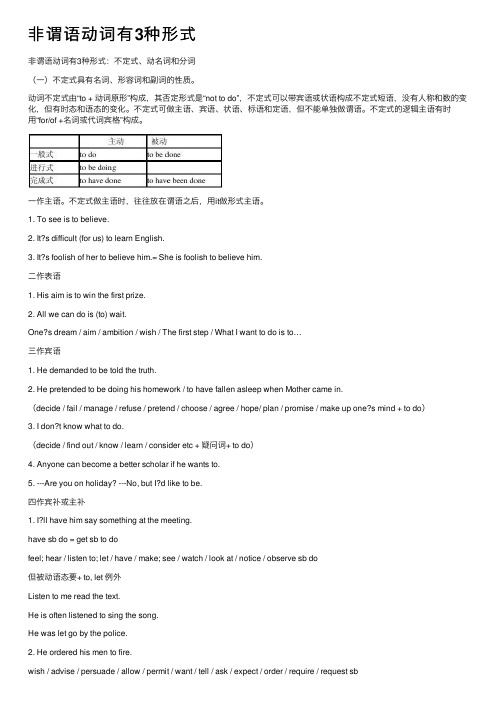
⾮谓语动词有3种形式⾮谓语动词有3种形式:不定式、动名词和分词(⼀)不定式具有名词、形容词和副词的性质。
动词不定式由“to + 动词原形”构成,其否定形式是“not to do”,不定式可以带宾语或状语构成不定式短语,没有⼈称和数的变化,但有时态和语态的变化。
不定式可做主语、宾语、状语、标语和定语,但不能单独做谓语。
不定式的逻辑主语有时⽤“for/of +名词或代词宾格”构成。
⼀作主语。
不定式做主语时,往往放在谓语之后,⽤it做形式主语。
1. To see is to believe.2. It?s difficult (for us) to learn English.3. It?s foolish of her to believe him.= She is foolish to believe him.⼆作表语1. His aim is to win the first prize.2. All we can do is (to) wait.One?s dream / aim / ambition / wish / The first step / What I want to do is to…三作宾语1. He demanded to be told the truth.2. He pretended to be doing his homework / to have fallen asleep when Mother came in.(decide / fail / manage / refuse / pretend / choose / agree / hope/ plan / promise / make up one?s mind + to do)3. I don?t know what to do.(decide / find out / know / learn / consider etc + 疑问词+ to do)4. Anyone can become a better scholar if he wants to.5. ---Are you on holiday? ---No, but I?d like to be.四作宾补或主补1. I?ll have him say something at the meeting.have sb do = get sb to dofeel; hear / listen to; let / have / make; see / watch / look at / notice / observe sb do但被动语态要+ to, let 例外Listen to me read the text.He is often listened to sing the song.He was let go by the police.to dosuggest / hope / agree / demand / arrange sb to do3. He is said to be doing the work of next year.It?s said that he is doing the work of next year.sb + seem / appear / happen / be said / be reported / be known /be found / be believed + to do / to be doing / to have ( been) doneIt + seem / appear / happen / be said … / be believe that….六作定语1. I have a lot of work to do / no pen to write with.2. the first to come / to be awarded the Nobel Prize3. the last person to do such a thing 最不愿意做…的⼈4. the house to be built next year⽐较: the house being built now / build last year注意(1)做定语的不定式如果是不及物动词,或者不定式所修饰的名词或代词是不定式动作的地点、⼯具等,不定式后应有相应的介词。
非谓语三种形式的区别和辨析

非谓语动词三种形式用法的区别:1. 做主语:v-ing & to do 都可以做主语,大多数情况两者没有区别。
注意:但是v-ed不可以做主语。
Exploring the Amazon River deserve s courage. ( doing 表抽象的概念)To explore the Amazon River deserve s courage. ( to do 表具体的/将来的动作)其余注意事项:1)Seeing is believing.To see is to believe. (即:主语与表语的形式要一致)但是不能说:Seeing is to believe; 或者To see is believing.2)Lincoln said it was not right for the south to break away from the union.Linda said it was nice of you to lend her money.The childre n’s loving nature can surely inspire their love for their familymembers.3) It is no good / no use / useless + doing sth 句型It’s no use crying over spilt milk.4) There is no + doing. 句型There is no knowing what will happen next. 谁也不知道下一步会发生什么。
There is no telling w hat will happen.谁也无法判断、辨别将要发生什么。
2. 做表语:My favorit e hobby is to collect / collect ing old coins. (一般概念to do/doing 可以互换)Our aim is to help the old lead a happy life. (表具体的/将来的动作用t o do)We were all greatly amazed at the childre n’s wonderf ul perform ance.The childre n’s wonderf ul perform a nce was amazing.3. 作宾语:用哪种形式做宾语往往跟动词的搭配用法有关like / love to do & like / love doing;begin / start to do & begin / start doing;prefer t o do & prefer d oing;continu e to do & continu e doing;try to do VS try doing;mean to do VS mean doing;can’t help doing VS can’t help (to) dogo on to do VS go on doing;stop to do VS stop doing;forget to do VS forget doing / forget having doneregret t o do VS regret d oing / regret having done;remembe r to do VS remembe r doing / remembe r having done;sth need doing & sth need to be done (需要)sth require doing & sth require to be done (需要)sth want doing & sth want to be done (需要)sth deserve doing & sth deserve to be done (值得)需要注意的重要形式:特殊疑问词(how / what / when/ where…) + to do = 宾语从句Hearing the sad news, I didn’t know what to do.= Hearing the sad news, I didn’t know what I could do.I couldn’t decidew hether to work another year or changemy job.= I couldn’t decidew hether I could work another year or change my job.2)it 做形式宾语,to do / doing做真正的宾语I though it an honor to have been invited to dinner. ( to be invited to dinner的完成式) I found it no use attempt ing to lose weight by going on diet.3)I’m looking forward to seeing you again.I have no choice but to stay home for another hour.I have nothing to do but stay home for another hour.I can do nothing but stay home for another hour.4. 作宾语补足语:(考试重点)I often noticea littleboy pass this corrido r and enter the garden.I found a strange r walking nearby our shop.( doing 强调动作正在进行;(看到、注意到)动作的一部分)( to do强调动作已经完成;(看到、注意到)动作的全过程请注意下列句子的区别:We heard her singing next door. (听到她唱歌动作的一部分;听到她正在唱歌) (主动正在进行)We heard her sing next door. (听到她唱歌动作的全部分;听到她唱过歌) (主动完成)We heard the song sung by her. (听到这首歌被她唱过) (被动完成)We heard the song being sung by her next door. (听到她这首歌正在被她唱)(被动正在进行)Don’t have the water running all the day. (让…一直做) (主动,一直进行)The teacher had him read the text three times. (让...做…)(主动,做具体一件事情)I had my hair colored last Friday.(让…由别人做;遭遇到不好的事情)(被动,有别人完成)注意跟I have a lot of homework to do today. (有) 的区别。
动词的非谓语形式有三种
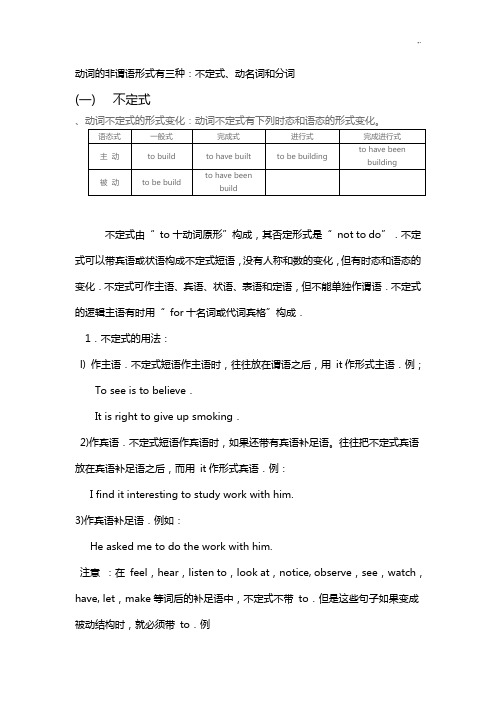
动词的非谓语形式有三种:不定式、动名词和分词(一)不定式不定式由“to十动词原形”构成,其否定形式是“not to do”.不定式可以带宾语或状语构成不定式短语,没有人称和数的变化,但有时态和语态的变化.不定式可作主语、宾语、状语、表语和定语,但不能单独作谓语.不定式的逻辑主语有时用“for十名词或代词宾格”构成.1.不定式的用法:l) 作主语.不定式短语作主语时,往往放在谓语之后,用it作形式主语.例;To see is to believe.It is right to give up smoking.2)作宾语.不定式短语作宾语时,如果还带有宾语补足语。
往往把不定式宾语放在宾语补足语之后,而用it作形式宾语.例:I find it interesting to study work with him.3)作宾语补足语.例如:He asked me to do the work with him.注意:在feel,hear,listen to,look at,notice, observe,see,watch,have, let,make等词后的补足语中,不定式不带to.但是这些句子如果变成被动结构时,就必须带to.例I often hear him sing the song.He is often heard to sing the song.注意:不定式动词在介词but,except,besides后面时,如果这些介词之前有行为动词do的各种形式,这些介词后的不定式不带to,否则要带to.如:She could do nothing but cry.What do you like to do besides swim?I have no choice but to go.4)作定语.例如:I have some books for you to read.注①作定语的不定式如果是不及物动词,或者不定式所修饰的名词或代词是不定式动作的地点、工具等,不定式后面须有相应的介词.例如:He is looking for a room to live in.There is nothing to worry about.Please give me a knife to cut with.但是,不定式所修饰的名词如果是time,place或way,不定式后面的介词习惯上要省去.例如:He had no money and no place to live.注②当作定语的不定式所修饰的名词或代词是不定式动作的承受者时,不定式既可以用主动语态,也可用被动语态,但其含义有所不同.试比较:A) Have you anything to send? 你有什么东西要寄吗?B) Have you anything to be sent? 你有什么要(我或别人)寄的东西吗?(不定式to be sent的动作执行者是已被省略的me或someone else)5)作状语,表示目的、原因、结果或条件.例如:I came here to see you.(目的)We were very excited to hear the news.(原因)He hurried to the school to find nobody there.(结果)To look at him, you would like him.(条件)目的状语还可以用in order to或so as to来表示.如:In order to pass the exam, he worked very hard.We ran all the way so as not to be late.不定式也可在作表语用的形容词后面作状语.例如:I am very glad to hear it.The question is difficult to answer.“too十形容词或副词十不定式”作状语.例如:He is too old to do that.另外句子中有enough这个词时,常用不定式作状语.例如:The room is big enough to hold us.6)作表语.例:My job is to help the patient.7)作独立成分.例;To tell the truth,I don’t agree with you.8)不定式与疑问词who,which,when,where,how,what等连用,在句中起名词作用,可充当主语、表语、宾语等.例如:He didn’t know what to say.(宾语)How to solve the problem is very important.(主语)My question is when to start. (表语)注意:在与why连用时,只用于why或why not开头的简短疑问句中,后面紧跟的动词不定式不带to. 例如:Why not have a rest?9)不定式在句中用主动式还是被动式。
高中英语非谓语动词to do(三)

The room was quite dark inside, so he made some candles to give light.(candles做了to give light的动作,是不定式的逻辑主语)注意:1)如果不定式所修饰的名词是time, place或way,不定式后面习惯上要省略介词。
He had no money and no place to live.2)不定式所修饰的名词或代词是不定式动作的承受者时,不定式既可用主动语态,又可用被动语态,但含义不同。
如果修饰名词的不定式的动作是主语做的, 不定式用主动语态。
试比较:•Have you anything to send?•Have you anything to be sent?3)不定式作定语多表示将来,而动词-ing形式表示正在进行或用途,过去分词则表示已经完成和被动。
a problem to be discussed tomorrow 明天要讨论的问题a problem being discussed now 现在正讨论的问题a problem discussed for thousands of years 已讨论多年的问题6.作状语A. 作修饰动词的目的状语They ran over to welcome the students.注意:不定式表示目的时前面可以加in order 或so as已示强调。
B. 作修饰动词的结果状语1)不定式作结果状语常表示一种事先没有预料到的情况或结果,放在被修饰动词的后面。
What have I said to make you so angry?2)有时为了进一步加强意料不到的语气,在表示结果的不定式前还可加only。
I went to see him only to find him out.7.动词不定式常用句型:(1) It takes / took / will take sb. some time / money to do sth.某人花/花了/将花多长时间/多少钱做某事. 例句:It took me years of hard work to speak good English.(2) It is + adj +for/of sb to do sth。
非谓语动词一览表
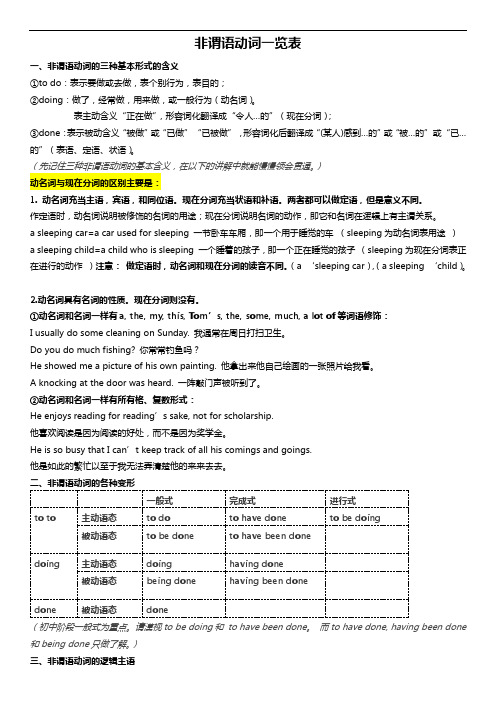
非谓语动词一览表一、非谓语动词的三种基本形式的含义①to do:表示要做或去做,表个别行为,表目的;②doing:做了,经常做,用来做,或一般行为(动名词)。
表主动含义“正在做”,形容词化翻译成“令人…的”(现在分词);③done:表示被动含义“被做”或“已做”“已被做”,形容词化后翻译成“(某人)感到…的”或“被…的”或“已…的”(表语、定语、状语)。
(先记住三种非谓语动词的基本含义,在以下的讲解中就能慢慢领会贯通。
)动名词与现在分词的区别主要是:1. 动名词充当主语,宾语,和同位语。
现在分词充当状语和补语。
两者都可以做定语,但是意义不同。
作定语时,动名词说明被修饰的名词的用途;现在分词说明名词的动作,即它和名词在逻辑上有主谓关系。
a sleeping car=a car used for sleeping 一节卧车车厢,即一个用于睡觉的车(sleeping为动名词表用途)a sleeping child=a child who is sleeping 一个睡着的孩子,即一个正在睡觉的孩子(sleeping为现在分词表正在进行的动作)注意:做定语时,动名词和现在分词的读音不同。
(a ‘sleeping car),(a sleeping ‘child)。
2.动名词具有名词的性质。
现在分词则没有。
①动名词和名词一样有a, the, my, this, Tom’s, the, some, much, a lot of等词语修饰:I usually do some cleaning on Sunday. 我通常在周日打扫卫生。
Do you do much fishing? 你常常钓鱼吗?He showed me a picture of his own painting. 他拿出来他自己绘画的一张照片给我看。
A knocking at the door was heard. 一阵敲门声被听到了。
②动名词和名词一样有所有格、复数形式:He enjoys reading for reading’s sake, not for scholarship.他喜欢阅读是因为阅读的好处,而不是因为奖学金。
2020年高考英语语法考点讲解与真题分析专题20:非谓语动词(三)
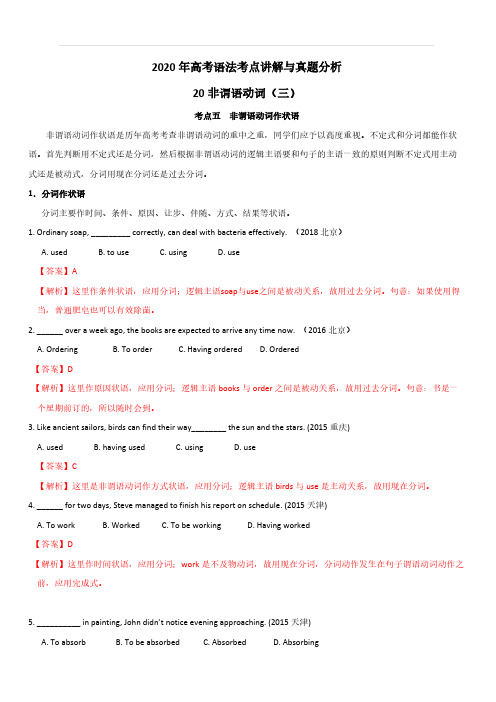
A. To absorb
B. To be absorbed
C. Absorbed
D. Absorbing
【答案】C
【解析】句意:由于专心画画,约翰没有注意到天色已晚。作原因状语,应用分词;John 与 absorb 之间是被动
关系,故用过去分词。
6. When I was little, my mother used to sit by my bed, ______ me stories till I till asleep, (2013 重庆)
A. To work
B. Worked C. To be working
D. Having worked
【答案】D
【解析】这里作时间状语,应用分词;work 是不及物动词,故用现在分词,分词动作发生在句子谓语动词动作之
前,应用完成式。
5. __________ in painting, John didn’t notice evening approaching. (2015 天津)
2. There are some health problems that, when ______ in time, can become bigger ones later on. (2013 浙江)
A. not treated B. not being treated
C. not to be treated D. not have been treated
A. surprising B. was surprised C. surprised D. being surprised
【答案】C
【解析】句意:虽然教授看见我们有些吃惊,但他还是热情地欢迎我们。分词作让步状语。分词与逻辑主语 the
动词的非谓语形式有三种不定式,动名词和分词
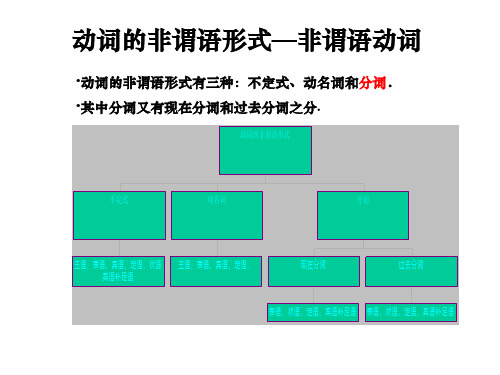
分词的用法 作宾语补足语
例如: We saw the teacher making the experiement.
注意:
• 在 see,hear,watch,feel,observe,have,listen to, notice等动词后,既可以用现在分词构成复合宾语, 也可以用不定式构成复合宾语,但两者的含义是有差 别的,用现在分词,表示动作正在发生,(即处于发 生的过程中,还没有结束),用不定式表示动作发生 了,(即动作全过程结束了)。 • 例如: • I saw the girl getting on the tractor. I saw the girl get on the tractor and drive off.
动词的非谓语形式—非谓语动词 动词的非谓语形式 非谓语动词
•动词的非谓语形式有三种:不定式、动名词和分词. 动词的非谓语形式有三种:不定式、动名词和分词. 动词的非谓语形式有三种 分词 •其中分词又有现在分词和过去分词之分 其中分词又有现在分词和过去分词之分. 其中分词又有现在分词和过去分词之分
动词的非谓语形式
注:
• 当分词的逻辑主语与主句的主语不同时:分词必 须有自己的主语. ( 独立结构) 例如: Time permitting, I will finish another lesson.
分词的用法 作表语
• 例如: The news is inspiring. The glass is broken.
“have +宾语+宾补”的几个句型比较: 注意宾补和宾语的关系!
“have + 宾语+do” 表示让某人做某事 “ have十宾语十doing” 表示主体使客体处于 某状态或一直在干什 么事; “ have十宾语十done” 表示动作是别人做的 或与主体意志无关.
三种非谓语的区别
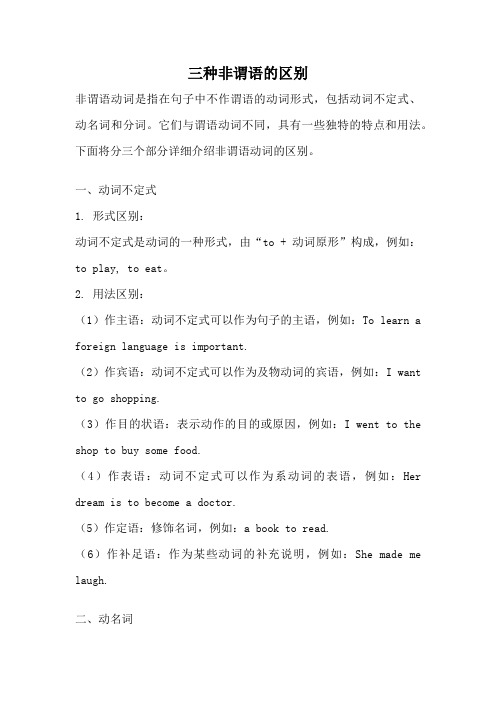
三种非谓语的区别非谓语动词是指在句子中不作谓语的动词形式,包括动词不定式、动名词和分词。
它们与谓语动词不同,具有一些独特的特点和用法。
下面将分三个部分详细介绍非谓语动词的区别。
一、动词不定式1. 形式区别:动词不定式是动词的一种形式,由“to + 动词原形”构成,例如:to play, to eat。
2. 用法区别:(1)作主语:动词不定式可以作为句子的主语,例如:To learn a foreign language is important.(2)作宾语:动词不定式可以作为及物动词的宾语,例如:I want to go shopping.(3)作目的状语:表示动作的目的或原因,例如:I went to the shop to buy some food.(4)作表语:动词不定式可以作为系动词的表语,例如:Her dream is to become a doctor.(5)作定语:修饰名词,例如:a book to read.(6)作补足语:作为某些动词的补充说明,例如:She made me laugh.二、动名词1. 形式区别:动名词是动词的一种形式,以-ing结尾,例如:playing, eating。
2. 用法区别:(1)作主语:动名词可以作为句子的主语,例如:Swimming is good for health.(2)作宾语:动名词可以作为及物动词的宾语,例如:I enjoy swimming.(3)作目的状语:表示动作的目的或原因,例如:I went swimming to relax.(4)作定语:修饰名词,例如:a running dog.(5)作表语:动名词可以作为系动词的表语,例如:His hobby is playing basketball.(6)作宾语补足语:作为某些动词的补充说明,例如:She saw him dancing.三、分词1. 形式区别:分词是动词的一种形式,分为现在分词和过去分词两种形式,例如:playing, eaten。
线练学校高三英语非谓语动词(三)

一. 教学内容:非谓语动词(三)二. 教学过程:6、动名词与不式作主语、宾语的用法比较1)作主语:(1)多数情况两者可以互换。
例如: Seeing is believing.=To see is to believe.Talking is easy and doing is difficult.=To talk is easy and to do is difficult.(2)如果表示一种具体、短期的行为,或者表示将来的行为,用不式。
例如:It took him two hours to finish the work.To be a scientist is his desire (愿望) .(3)如果表示一种时常性、习惯性的行为,普通用动名词。
例如:Getting up early is a good habit.2)作宾语:(1)有些动词跟不式、动名词作宾语皆可,意义也差不多,主要有: begin, start,continue, love, prefer。
(2)有些动词后只跟不式作宾语,主要有: wish, hope, expect, demand, refuse, decide.(3)有些动词后只能跟动名词作宾语,已学过的这种词有: finish, imagine, help, admit, avoid, mind, miss, insist on, enjoy, escape, consider, can practise, put off(延迟)=delay, suggest, feel like, look forward to, devote…to(doing) ,be worth.(4)有些动词后跟不式、动名词意义有明显差别,主要有: forget, remember, regret, stop, mean, try, want, need, require, go on①forget to do sth. 忘记要做某事forget doing sth. 忘记做过某事=forget having done sth.=forget to have done sth.②remember to do sth. 记住要做某事 remember doing sth.记住做过某事③regret to do sth. 遗憾(要)做某事 regret doing sth. 懊悔做了某事④stop to do sth. 停下(原事)去做某事(不式作目的状语)stop doing sth. 住手做某事⑤mean to do sth. 决意/打算做某事 mean doing sth. 意味/表明做某事⑥try to do sth. 努力/设法去做某事try doing sth. 试图/尝试用某一方法做某事⑦want/need/require to do sth. 要/想做某事want/need/require doing. 需要/想要被……⑧go on to do sth. 继续做不同的事 go on doing sth. 继续做相同的事7. 使用现在分词的几个注意点:(1)作状语用的现在分词,其逻辑主语必须同主语为同一人或者同一事,例如:①(正) Standing on top of the tall building,we could see the whole city.(Standing=When we stood)(误) Standing on top of the tall building,the whole city could be seen.②(正) Having found the cause, they continued the experiment.(Having found=After/When they had found)(误) Having found the cause, the experiment continued.(2)短暂动词(即瞬间动词)的现在分词被动式不可作宾补或者语。
动词的非谓语形式

动词的非谓语形式动词的非谓语形式有三种,即动词不定式,分词(现在分词和过去分词),动名词。
概说我们根据已经学过的语法知识知道,英语中动词有以下几类:助动词,情态动词,连系动词,行为动词(实义动词)。
助动词本身没有词义,不能单独使用,只能起到语法意义上的作用。
情态动词意思不完整,也不能单独使用,必须要和行为动词一起才能构成完整的意思,在句中作谓语。
连系动词作谓语时,后面接形容词和名词等作表语。
行为动词或实义动词在句中常作谓语,根据其后面能否直接带宾语,行为动词又可分为及物动词和不及物动词。
及物动词后面跟名词,代词或相当于名词的词作宾语,不及物动词必须要和一定的介词一起使用才能带宾语。
由上我们可以看出,行为动词在句中常常用做谓语,受主语的人称和数的限制。
但是,动词及其变化形式在句中也可以不作谓语来使用。
据此,我们又可将动词分为限定动词( finite verb )和非限定动词( non-finite verb )两类。
限定动词在句中作谓语,受主语的人称和数的限制,非限定动词在句中不可单独作谓语,不受主语的人称和数的限制,它在句中可以用作其他句子成分。
非限定动词有三种表现形式,既动词不定式,分词和动名词。
我们通常把这三种形式称之为动词的非谓语形式。
动词的非谓语形式或非限定动词在语法意义上具有双重性质:既具有动词性质,又具有非动词性质。
其动词性质表现在(1)有时式和语态的变化(2)可被状语修饰(3)及物动词须有宾语。
其非动词性质表现在(1)相当于名词(2)相当于形容词。
动词的三种非谓语形式与自己的宾语或状语连用就构成非限定动词短语,分别叫做动词不定式短语,分词短语和动名词短语。
动词不定式和动词不定式短语动词不定式在句中可作主语,主语补足语,宾语,宾语补足语,表语,定语,状语等。
动词不定式也有时式和语态的变化。
1.动词不定式作主语(a)To see is to believe.(b)To master a foreign language is of great importance today.(c)To teach is to learn.(d)It is a great honor to talk with you.2.动词不定式作主语补足语(a) He was seen to enter the hall.(b) It is reported to be true.(c)He is said to be from New York.(d)The young man was considered to have great promise.3.动词不定式作宾语(a) He seemed to know the secret.(b) I want to talk with him very much.(c) He liked to live there, However, he found it difficult to get used to the climate.4.动词不定式作宾语补足语(a)He begged me to give him a hand.(b)I would like you to have an opportunity to appreciate Chinese art.(c) I’ll leave you to attend the matter..(d) The boss made these workers work over 12 hours a day.5. 动词不定式作表语(a ) The duties of a postman are to deliver letters and newspapers.(b) My chief purpose has been to point out the difficulties of the matter.(c ) The important thing is to save lives.(d) The only thing I could do was to leave.(e) His wish is to become a doctor.6.动词不定式作定语(a)The next train to arrive was from Beijing.(b)He was always the first to come and the last to leave the office.(c)The four abilities to learn a language are listening, speaking, reading and writing.(d) Our need to communicate with each other has been a driving force in the developmentof technology.7.动词不定式作状语(a)He cupped his ears to hear better.(b)I stayed there to see what would happen.(c ) I come here to see you.(d) To emphasise the woman even more, Chen Yifei adds a lot of detail to the fan and thecloth of her dress.(e)Between 1933and 1940, Xu Beihong held several exhibitions in Asia and Europe topromote Chinese art.上述动词不定式或动词不定式短语在句中作目的状语。
- 1、下载文档前请自行甄别文档内容的完整性,平台不提供额外的编辑、内容补充、找答案等附加服务。
- 2、"仅部分预览"的文档,不可在线预览部分如存在完整性等问题,可反馈申请退款(可完整预览的文档不适用该条件!)。
- 3、如文档侵犯您的权益,请联系客服反馈,我们会尽快为您处理(人工客服工作时间:9:00-18:30)。
II. The syntax function of the gerund:
1. As subject:
E.g. Traveling takes less time than it used to be.
Smoking is harmful to people’s health. Trans: 照顾好这些婴儿是他们的工作。 Taking good care of these babies is their work. 他到这里来是我们的荣耀。
give up, put off, can’t stand, can’t help, feel like, insist on, have fun/a good time/trouble/difficulty, etc. ☆ need, want, require, deserve, be worth 等词后的 –ing分词,作宾语常表示被动意义:<+doing / to be done> (主动形式表被动意义) E.g. The room needs cleaning. ☆ the gerund VS the infinitive. (1) like, prefer, love, hate I like reading, but I don’t like to read now.
His coming here will be a great honour to us.
☆ 动名词作主语表示一般的或抽象的,习惯性的多次 行为,一般不与特定的执行者有关系。不定式作主 语往往表示具体的或一次性的动作。
E.g. Playing with fire is dangerous. It is unsuitable to go swimming this afternoon.
E.g. He was praised for having saved the drowning man. ☆ the passive voice of the gerund:
A. Simple: being done B. perfect: having been done
E.g. He came in without being asked.
(8) try Try to get there early. Try knocking at the back door if nobody hears you at the front door. 4. As attribute (the gerund VS the present participle)
☆ the gerund has the characters of noun,it can
be modified with articles, adjectives, and this, some, my etc.
E.g. You should give the room a good cleaning. This evening I think I’ll do some reading. Early rising is good for health.
(2) stop
They stopped talking. / They stopped to talk.
(3) go on Let’s go on reading the text. Let’s go on to read the text. (4) remember I remember seeing her somewhere last year. I should remember to see her before she leaves. (5) forget I shall never forget visiting New York in 1988. He had forgotten to take his umbrella and he was wet through. (6) regret
Grammar
S2-W3
By Lily
The Gerund (动名词)
The gerund = V + ing The gerund = verb form but noun function I. The forms of the gerund(eg: do)
Active Simple perfect doing having done Passive being done having been done
I regret missing the chance.( = having missed … ) I regret to tell you that I can’t help you. telling / having told I regret ___________________(tell) her the bad news. Now she is sad all day.
Negative form:
not + gerund
☆ the tenses of the gerund: A. simple tense: doing We enjoy watching football. We object to attending the lecture.
B. perfect tense: having done
I don’t remember having been given such a large sum of money.
II. The particularity of the gerund: ☆ the gerund has the characters of verb, it can have
Remember: admit, appreciate, avoid, consider, delay, deny, dislike, enjoy, escape, excuse, finish, forgive, imagine, involve, keep, mind, miss, practise, resist, risk, suggest, understand, etc. Remember: devote to, look forward to, stick to, be/get used to, object to, be worth …, pay attention to, stick to, be proud of, be fond of, prevent…from, succeed in, be responsible for,
Verb filling
found crying 1. Dusk ________(find) Lily ________ (cry) in the street because of hunger. 2. Mike works at a garage and so spends much lying time ________ (lie) under motorcars. being asked 3. “A party!” she cried, “ I love ____________ (ask) to parties. 4. Be careful while crossing the street. Don’t being knocked forget _____________ (knock) over by a bike last week.
区别:动名词作定语,说明名词的用途;现在分词作定 语,表示所修饰人或物的动作。
E.g. a swimming pool C.f. a swimming boy a waiting room C.f. a waiting car 5. No + the gerund,构成动名词的惯用语,多用于表 示简短的禁令或禁律。 E.g. No smoking at school, please. / No spitting.
6. go + the gerund,大部分是由于表示文艺体育活动 的习惯用语。
E.g. go boating, go bowling, go camping
7.动名词的复合结构:
名词所有格或物主代词后加动名词,即构成动名词复合 结构,在句中多作主语或宾语。 E.g. My sister’s being ill made us worried. His coming here is a great honour to us. Would you mind my using your pen? I don’t like your saying that.
(7) mean
Sorry, I didn’t mean to hurt you. If you don’t work hard here, it means wasting time and money. If you mean _____ more, that means ____overtime. D A. being paid…working B. being paid…to work C. to be paid…to work D. to be paid…working
5.I’ll consider ______(see) Mr. Bush at the office seeing this afternoon, but I’m not sure if I have the time. 6. If no one answer the front door, why not knocking try___________ (knock) at the back door. 7. I really regret __________ (waste) so much wasting time_________ (play) TV-video games. playing 8. He didn’t feel well and suggested being given ____________(give) a good medical examination. 9.Football seems ________ ( excite) to most of exciting the boy. feeling 10. I can’t help ______ ( feel) anxious about his health.
